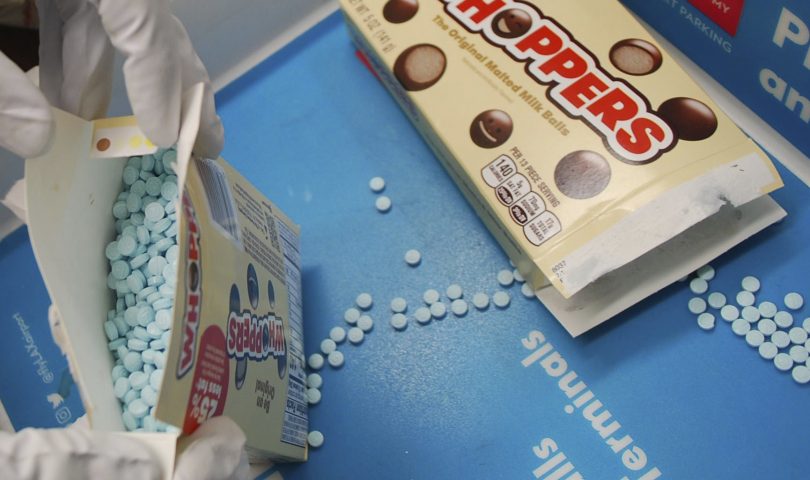MORGANTOWN – As Halloween approaches, elected officials and medical experts are warning parents – and kids – to be aware of a growing trend of drug traffickers disguising fentanyl as candy.
Sen. Shelley Moore Capito has joined 12 other GOP senators to put out a public service announcement about the problem. And following a Monongalia County drug bust where so-called “rainbow fentanyl” was seized, three WVU pharmacy professors joined to issue their own warning.
Elizabeth Scharman, clinical and executive director of the West Virginia Poison Center and a professor of clinical pharmacy, told The Dominion Post that counterfeit medications aren’t exactly new. Traffickers obtain or make tablet presses and form bogus pain meds with the prescription drug imprints. They’re typically various colors.
In August, The Dominion Post reported on a Mon County drug bust where fentanyl-laced oxycodone tablets and other illicit drugs were seized. U.S. Attorney William Ihlenfeld said at the time the pills were “part of a new trend that we’re seeing, that they are candy colored. They have all the colors of the rainbow on these pills.”
Capito has put out a solo PSA about the problem; The 13 senators also teamed on a joint PSA where each presents a portion of the message.
The PSA says, “The powerful drug cartels are coming after your kids, your neighbors, your students, your family members and your friends. Fake pills laced with fentanyl are beginning to look like candy in an effort to lure young Americans. This is also known as rainbow fentanyl.
“Rainbow fentanyl comes in a variety of bright colors, shapes and sizes, including pills, powder and blocks that resemble sidewalk chalk,” the PSA says.
It cites a Drug Enforcement Agency press release that says, “Rainbow fentanyl — fentanyl pills and powder that come in a variety of bright colors, shapes and sizes — is a deliberate effort by drug traffickers to drive addiction amongst kids and young adults.”
The theme of the PSA and the message of the WVU professors is “One Pill Can Kill,” based on a DEA campaign. The PSA says, “Even just handling these pills or powders disguised as candy can kill a person. All it takes is one pill, or enough powder to fit on the tip of a pencil, to poison and kill someone.”
Capito and Scharman both said the the bogus meds are made to emulate a variety of pain and anti-anxiety medications: Percocet, oxycodone, Xanax, and Adderall; and all are being laced with fentanyl.
Scharman said in the group release that the West Virginia Poison Center had 212 reports of fentanyl exposure in 2021. Often, heroin users will unwittingly buy heroin mixed with fentanyl or fentanyl by itself. So that 212 figure may be an underestimate.
The most common counterfeit prescription drug reported to the West Virginia Poison Center is Xanax, a benzodiazepine sedative, which is pressed into tablets containing fentanyl made to look like Xanax bars, she said.
Opioids build tolerance, Scharman said. Over time, it takes more drug to get the same effect. A user will need more oxycode tablets, and turn to the more potent heroin. Then tolerance will build and they’ll turn to fentanyl. When tolerance to that builds, they may turn to synthetic fentanly analogs that are even stronger.
The analogs pose a couple additional problems, she said. One, their novel formulations won’t fall into the federal and state drug schedules and temporarily won’t be illegal until officials can analyze them and schedule them.
Another problem is that some of the analogs aren’t related to fentanyl and won’t be detected by fentanyl test strips “Using a fentanyl detection strip and not seeing fentanyl doesn’t mean you’re in the clear,” she said.
As your kids and neighbors go trick-or-treating, the question arises, will they get rainbow fentanyl dropped in their treat bags?
Likely not, Scharman said. The drugs are expensive and there’s no value in giving it away, or possibly killing a future customer.
But there are other issues. A user who lives with children should store their drugs out of reach. Kids might accidentally consume them thinking they’re candy. And that goes for legal gummies and other edibles that contain medical cannabis, CBD or delta-8 THC.
But don’t presume kids will be safe trick-or-treating. The officials who took part in the California drug bust echoed what Capito and her colleagues said in their PSA.
“Only let kids take candy from trusted neighbors, family and friends,” the PSA says. “Set a curfew for trick-or-treaters. Always double, and triple check, their candy for drugs, or suspiciously packaged or unpackaged items. And remind kids to trick-or-treat in groups, and to check in with parents periodically.”
Tweet David Beard @dbeardtdp Email dbeard@dominionpost.com




